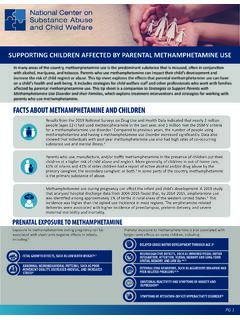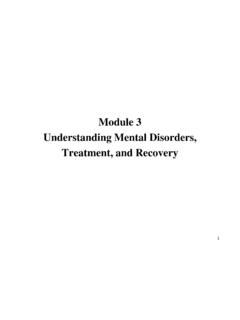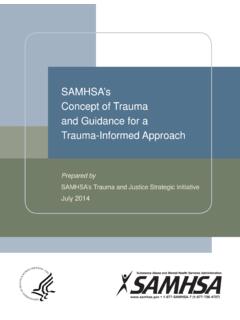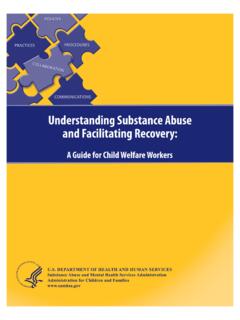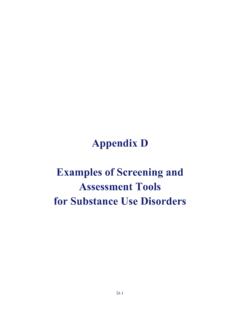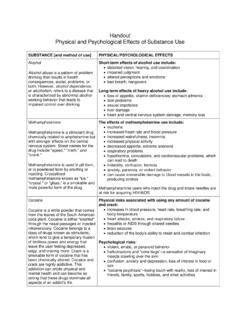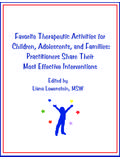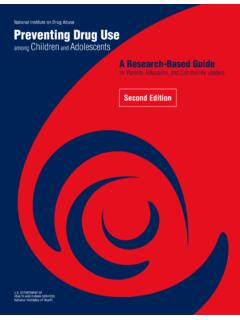Transcription of WORKING WITH ADOLESCENTS: PRACTICE TIPS AND …
1 National Center on Substance Abuse and Child Welfare WORKING WITH ADOLESCENTS: PRACTICE TIPS AND RESOURCE GUIDE. The National Center on Substance Abuse and Child Welfare (NCSACW) developed this technical assistance (TA) tool to provide information to child welfare, substance use treatment providers, healthcare, and other community agencies serving adolescents at risk of misusing or abusing substances. This resource highlights adolescence as a unique stage of development one that requires professionals to take a tailored and collaborative approach. It also provides a comprehensive array of adolescent services, terminology, policy considerations, and PRACTICE strategies to support those WORKING with adolescents through a family-centered lens. Substance use disorders (SUDs) affect the entire family. They can interfere with a parent's ability to be a caretaker and bond with a child, while also disrupting family health and well-being. Traditional SUD treatment focuses on the individual, despite evidence that parents and children are most effectively served through a family-centered treatment approach.
2 In 2019, parental alcohol or drug abuse factored into the removal of nearly 40% of all children who entered out-of-home (OOH) care. Adolescents made up Youth who enter foster care between the ages of 13 and 17 are more likely to exit the child welfare system through emancipation rather than family reunification; that number increases for older Child welfare workers indicate a much higher prevalence of parental substance use than reported in their caseloads. This is primarily due to the variation in the national data since states and counties differ in how they use screening tools and track substance use as a factor in child welfare cases. Research shows a significant relationship between child maltreatment and adolescent delinquency, including developmental pathways to substance ,4,5 children affected by child abuse or neglect have a 59% greater likelihood of arrest as a juvenile, a 28% greater likelihood of arrest at as an adult, and a 30% greater likelihood of committng a violent Adolescence is a time period with specific health and developmental needs.
3 A successful transition from childhood to adulthood can be difficult even under the best circumstances. For youth in foster care, the trauma associated with removal, combined with a lack of guidance and support tailored to this stage of development, can further complicate the transition. Professionals often overlook adolescent needs when addressing the family system since generalized services are geared toward two populations: adults and children ages 0 - 18. However, it is a critical time when the potential for SUDs and/or mental health concerns emerge. Consideration of each adolescent development domain supports a tailored approach for service delivery effectively meeting the needs of this population and their families. Youth need nurturing support to navigate the developmental milestones of adolescence. By focusing on development, protective factors, fostering healthy relationships and resilience, providing opportunities, and enhancing youth strengths, professionals can help these young adults reach full potential.
4 The Center for the Study of Social Policy (CSSP) publications, Youth Thrive: Promoting Youth Resilience and Youth Resilience: Protective and Promotive Factors, suggest questions to ask youth; offer steps professionals can take to foster resilience, social connections, cognitive and social-emotional development; identify concrete supports in times of need; and provide activities to assist those WORKING directly with youth. DEFINING ADOLESCENCE. Adolescence is the transition period from childhood to adulthood, including physical and psychological changes beginning around puberty and extending to age While the World Health Organization (WHO) acknowledges that age is a convenient way to define adolescence, it is just one characteristic. Age is often a more appropriate method to assess and compare biological changes, which are universal, than social transitions, which can depend more on cultural environment. The practical definition of adolescence varies widely.
5 For example, the Department of Health and Human Services (HHS)/Office of Population Affairs (OPA) notes adolescence beginning as early as age WHO suggests this stage starts at 10,9 while the Centers for Disease Control and Prevention (CDC) lists the age as PG 1. WORKING WITH ADOLESCENTS: PRACTICE TIPS AND RESOURCE GUIDE. NCSACW defines adolescence as ages 12-18. This correlates with the Substance Abuse and Mental Health Services Administration's (SAMHSA) definition,11 the National Institute on Drug Abuse's (NIDA) Principles of adolescent Substance Use Disorder Treatment: A. Research-Based Guide,12 and SAMHSA's Treatment Episode Data Late adolescence or young adulthood is another critical life stage as individuals move toward independence-assuming responsibility for their own care and well-being, while also creating adult identities/4 Like adolescence, the exact definition of young adulthood . remains imprecise. This stage includes psychosocial transitions such as gradual independence from family, as well as changes to residence, employment, education, finances, romance, and parenting status15 none of which are uniformly accomplished by a specific age.
6 These factors also largely depend on culture/6 SAMHSA defines young adults as ages 18-25/7. Transitional age youth as defined in the Department of Education's Foster Care Transition Toolkit includes all youth transitioning out the child welfare system. This can be as early as age 18 or as late as 23 in some States, through the John H. Chafee Foster Care Program for Successful Transition to Adulthood (the Chafee program), can provide financial, housing, employment, education, and other support services to prepare youth for the transition from foster care to living on their own. The program is available to youth who have experienced foster care at age 14 or older. The Family First Prevention Services Act (FFPSA) made amendments to the Chafee program in 2018 which permits states and Tribes to provide the program up to age 23 under certain 5C's THE 5 C's OF POSITIVE YOUTH DEVELOPMENT. The adolescent years are full of potential. While it is vital to encourage teens to avoid risky behaviors, it's also important to cultivate their positive qualities.
7 Positive youth development views teens as having a lot to offer, while promoting the idea that adults can make a significant and positive difference in their lives by helping foster competence, confidence, connections, character, and ASSET DEFINITION HOW TO FOSTER IT. Perception that one has Provide services that support training and PRACTICE in COMPETENCE abilities and skills specific skills, either academic or hands-on Internal sense of Provide opportunities for adolescents to experience self-efficacy and positive success when trying something new CONFIDENCE self-worth Positive bonds with Help to foster and encourage relationships between people and institutions youth and peers, teachers, parents and families of CONNECTIONS origin, and families of choice A sense of right and wrong (morality), integrity, and Provide opportunities to PRACTICE increasing respect for standards of self-control and development of spirituality CHARACTER correct behavior A sense of sympathy and Care for young people empathy for others CARING.
8 Adapted from The Teen Years Explained: A Guide to Healthy adolescent Development by Clea McNeely, MA, DrPH and Jayne Blanchard PG 2. WORKING WITH ADOLESCENTS: PRACTICE TIPS AND RESOURCE GUIDE. No single individual or agency can provide all the assistance young people need to thrive. It's crucial that communities come together to support adolescents with complex needs. Special adolescent populations include minority youth; children of parents with SUDs or other substance use issues; transitional aged youth; pregnant and parenting teens; youth with mental health needs and high Adverse Childhood Experiences (ACEs) scores; youth involved with both child welfare and juvenile justice (also known as crossover youth); young people in recovery; and Lesbian, Gay, Bisexual, Transgender, and Questioning (LGBTQ) youth. Child welfare agencies should seek opportunities to work with substance use treatment providers, educators, mental health professionals, juvenile justice professionals, court staff, and others serving youth in foster This helps ensure an adolescent -focused framework that supports the complex needs of all involved.
9 The Interagency WORKING Group on Youth Programs ( WORKING Group) has developed a strategic plan, Pathways for Youth: Draft Strategic Plan for Federal Collaboration, as a first step. The plan helps partners address their common goals for youth; elevate strong models of youth programs, policies, and other supports; and articulate areas for future collaborative work with and for youth. adolescent POPULATIONS. Many adolescent subpopulations, with either a personal or family history of using substances, present with different needs especially youth with history in the child welfare system and transitional aged youth. Serving adolescents effectively means understanding potential youth at risk, youth currently misusing and abusing substances, and those in recovery. Staff can identify this subpopulation along the SUD continuum of prevention, intervention and treatment, and recovery supports. YOUTH AT YOUTH MISSING YOUTH IN. RISK & ABUSING RECOVERY. Prevention Intervention Recovery and Treament Supports Youth of parents with SUDs Crossover youth Young people in recovery High ACEs scores Transitional age youth Recovery supports Mental health concerns Foster age youth Pregnant and parenting Youth diagnosed with SUD.
10 Minority youth LGBTQ youth Youth with a history of family dysfunction, especially in the above groups, may be estranged from their family of origin (birth families) resulting in the creation of a family of choice." Families of choice are people selected by an individual to support their personal journey for recovery; they're not limited to biological or legal definitions. Professionals should explore the definition of family for each youth and incorporate their chosen family as an opportunity for engagement. YOUTH AT RISK: PREVENTION. Families are the most critical setting for child development. Risk factors such as poverty, single parenthood, dysfunction, abuse or trauma, parental mental illness, parental substance use, and family discord or illness negatively affect both the family unit and a child's life outcome in Adverse experiences ( , parental substance use, domestic violence, poverty), which often push youth into the at risk category, influence childhood maltreatment and trauma linked to physical, psychological, and behavioral consequences later in Youth at risk" is a general term for a range of circumstances that place young people at greater vulnerability for problem behaviors such as substance abuse, school failure, juvenile delinquency, and mental health Individual factors include development of an SUD; high Adverse Childhood Experiences (ACEs) scores; mental health concerns; and youth who experiment with substances placing them at risk for developing an SUD (especially in the presence of other risk factors).
